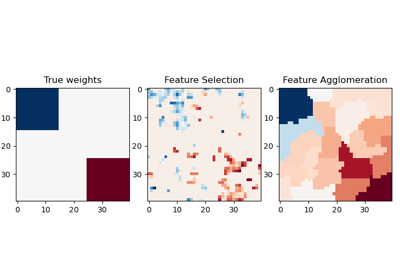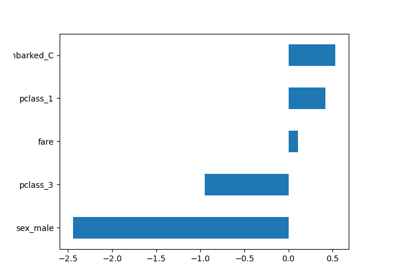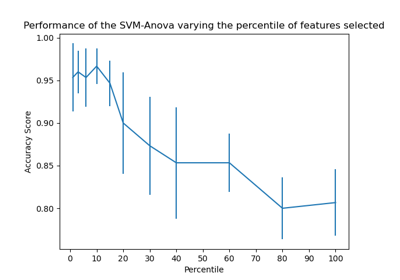SelectPercentile#
- class sklearn.feature_selection.SelectPercentile(score_func=<function f_classif>, *, percentile=10)[source]#
Select features according to a percentile of the highest scores.
Read more in the User Guide.
- Parameters:
- score_funccallable, default=f_classif
Function taking two arrays X and y, and returning a pair of arrays (scores, pvalues) or a single array with scores. Default is f_classif (see below “See Also”). The default function only works with classification tasks.
Added in version 0.18.
- percentileint, default=10
Percent of features to keep.
- Attributes:
- scores_array-like of shape (n_features,)
Scores of features.
- pvalues_array-like of shape (n_features,)
p-values of feature scores, None if
score_funcreturned only scores.- n_features_in_int
Number of features seen during fit.
Added in version 0.24.
- feature_names_in_ndarray of shape (
n_features_in_,) Names of features seen during fit. Defined only when
Xhas feature names that are all strings.Added in version 1.0.
See also
f_classifANOVA F-value between label/feature for classification tasks.
mutual_info_classifMutual information for a discrete target.
chi2Chi-squared stats of non-negative features for classification tasks.
f_regressionF-value between label/feature for regression tasks.
mutual_info_regressionMutual information for a continuous target.
SelectKBestSelect features based on the k highest scores.
SelectFprSelect features based on a false positive rate test.
SelectFdrSelect features based on an estimated false discovery rate.
SelectFweSelect features based on family-wise error rate.
GenericUnivariateSelectUnivariate feature selector with configurable mode.
Notes
Ties between features with equal scores will be broken in an unspecified way.
This filter supports unsupervised feature selection that only requests
Xfor computing the scores.Examples
>>> from sklearn.datasets import load_digits >>> from sklearn.feature_selection import SelectPercentile, chi2 >>> X, y = load_digits(return_X_y=True) >>> X.shape (1797, 64) >>> X_new = SelectPercentile(chi2, percentile=10).fit_transform(X, y) >>> X_new.shape (1797, 7)
- fit(X, y=None)[source]#
Run score function on (X, y) and get the appropriate features.
- Parameters:
- Xarray-like of shape (n_samples, n_features)
The training input samples.
- yarray-like of shape (n_samples,) or None
The target values (class labels in classification, real numbers in regression). If the selector is unsupervised then
ycan be set toNone.
- Returns:
- selfobject
Returns the instance itself.
- fit_transform(X, y=None, **fit_params)[source]#
Fit to data, then transform it.
Fits transformer to
Xandywith optional parametersfit_paramsand returns a transformed version ofX.- Parameters:
- Xarray-like of shape (n_samples, n_features)
Input samples.
- yarray-like of shape (n_samples,) or (n_samples, n_outputs), default=None
Target values (None for unsupervised transformations).
- **fit_paramsdict
Additional fit parameters.
- Returns:
- X_newndarray array of shape (n_samples, n_features_new)
Transformed array.
- get_feature_names_out(input_features=None)[source]#
Mask feature names according to selected features.
- Parameters:
- input_featuresarray-like of str or None, default=None
Input features.
If
input_featuresisNone, thenfeature_names_in_is used as feature names in. Iffeature_names_in_is not defined, then the following input feature names are generated:["x0", "x1", ..., "x(n_features_in_ - 1)"].If
input_featuresis an array-like, theninput_featuresmust matchfeature_names_in_iffeature_names_in_is defined.
- Returns:
- feature_names_outndarray of str objects
Transformed feature names.
- get_metadata_routing()[source]#
Get metadata routing of this object.
Please check User Guide on how the routing mechanism works.
- Returns:
- routingMetadataRequest
A
MetadataRequestencapsulating routing information.
- get_params(deep=True)[source]#
Get parameters for this estimator.
- Parameters:
- deepbool, default=True
If True, will return the parameters for this estimator and contained subobjects that are estimators.
- Returns:
- paramsdict
Parameter names mapped to their values.
- get_support(indices=False)[source]#
Get a mask, or integer index, of the features selected.
- Parameters:
- indicesbool, default=False
If True, the return value will be an array of integers, rather than a boolean mask.
- Returns:
- supportarray
An index that selects the retained features from a feature vector. If
indicesis False, this is a boolean array of shape [# input features], in which an element is True iff its corresponding feature is selected for retention. Ifindicesis True, this is an integer array of shape [# output features] whose values are indices into the input feature vector.
- inverse_transform(X)[source]#
Reverse the transformation operation.
- Parameters:
- Xarray of shape [n_samples, n_selected_features]
The input samples.
- Returns:
- X_originalarray of shape [n_samples, n_original_features]
Xwith columns of zeros inserted where features would have been removed bytransform.
- set_output(*, transform=None)[source]#
Set output container.
See Introducing the set_output API for an example on how to use the API.
- Parameters:
- transform{“default”, “pandas”, “polars”}, default=None
Configure output of
transformandfit_transform."default": Default output format of a transformer"pandas": DataFrame output"polars": Polars outputNone: Transform configuration is unchanged
Added in version 1.4:
"polars"option was added.
- Returns:
- selfestimator instance
Estimator instance.
- set_params(**params)[source]#
Set the parameters of this estimator.
The method works on simple estimators as well as on nested objects (such as
Pipeline). The latter have parameters of the form<component>__<parameter>so that it’s possible to update each component of a nested object.- Parameters:
- **paramsdict
Estimator parameters.
- Returns:
- selfestimator instance
Estimator instance.




